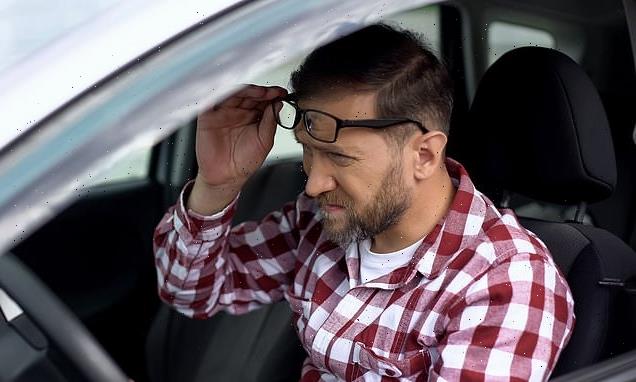People who are short-sighted sleep WORSE than those with normal vision, study finds
- Scientists analysed circadian timing and melatonin production in students
- Melatonin is a naturally-occurring hormone that helps control sleep patterns
- Short-sighted people had delayed circadian rhythms and lower melatonin
- The findings could aid in early diagnosis and treatment of myopia in children
It’s a condition that affects up to 30 per cent of adults and 10 per cent per cent of children, and now a new study has linked short-sightedness to poor sleep quality.
Researchers from Flinders University found that people with myopia (the medical term for short-sightedness) have poorer quality sleep than people with normal vision due to delayed circadian rhythms and lower production of melatonin – the hormone responsible for regulating sleep at night.
The team hopes their findings will aid in early diagnosis and treatment of myopia in children.
Researchers from Flinders University found that people with myopia (the medical term for short-sightedness) have poorer quality sleep than people with normal vision due to delayed circadian rhythms and lower production of melatonin – the hormone responsible for regulating sleep at night (stock image)
What is melatonin?
Melatonin is a hormone that occurs naturally in your body. It helps control your sleep patterns.
You can take a manmade version of melatonin for short-term sleep problems (insomnia). It makes you fall asleep quicker and less likely to wake up during the night. It can also help with symptoms of jetlag.
Melatonin is used to treat sleep problems in people aged 55 and over.
It can sometimes be prescribed to help with sleep problems in children and to prevent headaches in adults.
Melatonin is available on prescription only. It comes as slow-release tablets and a liquid that you drink.
Source: NHS
Myopia is a very common eye condition that causes distant objects to appear blurred, while close objects can be seen clearly.
The NHS explained: ‘Short-sightedness can range from mild, where treatment may not be required, to severe, where a person’s vision is significantly affected.
‘In children the condition can start from 6 to 13 years.
‘During the teenage years when the body grows rapidly myopia may become worse. Myopia can occur in adults.’
In the study, the researchers set out to understand whether or not myopia also affects the quality of sleep.
The team analysed circadian rhythms – 24-hour cycles that are part of the body’s internal clock – and melatonin production in university students in their twenties, some of who had myopia, and some with normal sight.
An analysis of the results revealed that participants with myopia had significantly delayed circadian rhythms and lower outputs of melatonin in their saliva and urine compared to normal sighted participants.
Dr Ranjay Chakraborty, who led the study, said: ‘Disruptions in circadian rhythms and sleep due to the advent of artificial light and the use of light-emitting electronic devices for reading and entertainment has become a recognised health concern in several fields, but its impact on eye health has not been studied extensively.
‘These findings provide important evidence that optimal sleep and circadian rhythms are not only essential for general health, but also for good vision.’
Based on the findings, the researchers are calling for children’s sleeping habits and exposure to screens to be re-evaluated to reduce their risk of developing myopia.
‘Adequate sleep is critical for learning, memory, sustained attention, academic performance at school, and general wellbeing of children during the early development,’ Dr Chakraborty explained.
An analysis of the results revealed that participants with myopia had significantly delayed circadian rhythms and lower outputs of melatonin in their saliva and urine compared to normal sighted participants (stock image)
‘A lot of digital devices emit blue light, which can suppress the production of melatonin and cause delay in circadian rhythms at night, resulting in delayed and poor sleep.
‘It is important to limit the exposure to digital devices in children, particularly at night, for ensuring good sleep and healthy vision.’
The team now plans to follow up by further assessing circadian rhythm timing.
Dr Chakraborty added: ‘Because myopia typically develops during childhood, as a next step, we would like to examine circadian rhythm timing, total production of melatonin sleep and light exposure at night in young children – the actual target population for myopia prevention.
‘Such a study will provide novel insights into the biological and environmental factors underlying myopia, which will aid in early diagnosis and treatment of myopia in children.’
THE DIFFERENCE BETWEEN SHORT AND LONG -SIGHTEDNESS?
Both short-sightedness and long-sightedness are common conditions which diminish a person’s eyesight.
Short-sighted people (myopic) have difficulty seeing objects at a distance.
They favour objects that are closer to them.
Their vision is clear when looking at things up close, but further away objects become out of focus or blurred.
Short-sightedness (myopia) occurs when the distance from the front to the back of the cornea’s curve is too steep.
This forces the light to focus in front of the retina, making objects in the distance appear blurred.
Long-sightedness (hyperopia) is the opposite of this and allows people to see objects clearly at a distance but find it hard to focus on things close to them.
This makes day-to-day activities such as working, reading or watching TV difficult and can result in eye strain. This then produces fatigue and headaches.
Long-sightedness occurs when the distance from the front to the back of the cornea’s curve is too steep.
Source: Read Full Article


